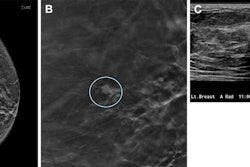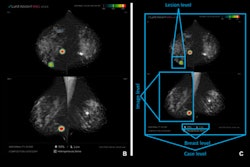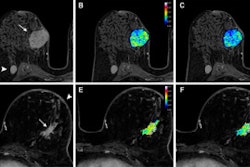A breast-specific diffusion-weighted imaging (DWI)-MRI technique is effective for distinguishing between breast lesion types -- and improves on dynamic contrast-enhanced (DCE) MRI for this purpose, researchers have reported.
A team led by Stephane Loubrie, PhD, of the University of California San Diego in La Jolla found that information generated by a DWI-MRI technique called restriction spectrum imaging (RSI) showed significant difference between cancers and high-risk benign lesions compared with average-risk benign lesions. The study results were published on 18 September in the Journal of Magnetic Resonance Imaging.
Breast cancer screening with DCE-MRI is recommended for women at high risk of the disease, but it has limitations, including variable specificity and difficulty in distinguishing lesion types, the group explained. What's needed are "complementary, noninvasive imaging techniques ... to improve specificity," the authors noted, and that's why using DW-MRI shows promise.
Loubrie's team conducted a study that assessed the ability of an existing restriction spectrum imaging DWI-MRI model called BS-RSI3C to categorize a range of lesion types in a screening population. The study included 187 women, 49 of whom had undergone mammography and had been recommended for additional imaging and 138 of whom were considered high-risk and were undergoing breast MRI before biopsy. The team estimated five "signal contributions" from the model.
Of these five signals, three showed significant differences in high-risk benign lesions compared with average-risk benign ones and one of the five had the highest area under the receiver operating curve (AUC) for distinguishing combined cancerous and high-risk lesions from average-risk benign ones compared to apparent diffusion coefficient (ADC) values (which DW-MRI generates and which correlate to tissue cellularity).
| Performance of the BS-RSI3C compared with ADC values for distinguishing between types of breast lesions on DW-MRI | ||
|---|---|---|
| Measure | Apparent diffusion coefficient | BS-RSI3C model |
| AUC | 0.69 | 0.82 |
"The BS-RSI3C model results showed a differentiation between average-risk benign lesions and cancerous lesions in a screening population," the authors wrote. "This is likely due to the BS-RSI3C model's known ability to estimate tumor cellularity, which is increased in hypercellular malignant tumors and lesions with abnormal cellularity."
The study findings could translate to more tailored care for women with breast cancer, according to the team.
"[Our results show] that restriction spectrum imaging has potential to complement standard-of-care DCE-MRI for increased diagnostic specificity and to guide surgical management of breast lesions," it concluded.
The complete study can be found here. Contract grant sponsor: GE Healthcare Research Grant; Contract grant sponsor: Krueger v. Wyeth Research Award; Contract grant sponsor: RSNA Research Resident Award; Contract grant sponsor: NCI/NIH; Contract grant number: 5R37CA249659.




















